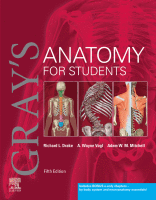Physical Address
304 North Cardinal St.
Dorchester Center, MA 02124

ADDITIONAL LEARNING RESOURCES for Chapter 5, Pelvis and Perineum, Can be Found on the Accompanying Ebook Conceptual overview General Description The pelvis and perineum are interrelated regions associated with the pelvic bones and terminal parts of the vertebral column. The…

ADDITIONAL LEARNING RESOURCES for Chapter 4, Abdomen, can be Found on the Accompanying Ebook Conceptual overview General Description The abdomen is a roughly cylindrical chamber extending from the inferior margin of the thorax to the superior margin of the pelvis…

ADDITIONAL LEARNING RESOURCES for Chapter 3, Thorax, CAN BE FOUND ON THE ACCOMPANYING EBOOK Conceptual overview General Description The thorax is an irregularly shaped cylinder with a narrow opening (superior thoracic aperture) superiorly and a relatively large opening (inferior thoracic…

ADDITIONAL LEARNING RESOURCES for Chapter 2, Back, Can be Found on the Accompanying Ebook Conceptual overview General Description The back consists of the posterior aspect of the body and provides the musculoskeletal axis of support for the trunk. Bony elements…

ADDITIONAL LEARNING RESOURCES for Chapter 1, The Body, CAN BE FOUND ON THE ACCOMPANYING EBOOK What is anatomy? Anatomy includes those structures that can be seen grossly (without the aid of magnification) and microscopically (with the aid of magnification). Typically,…
General organization The nervous system allows us both to detect and respond to our external environment and to monitor and control our viscera. The brain and spinal cord are central in position and are wired to the rest of the…
General organization The lymphatic system is a network of thin-walled vessels throughout the body that collect fluid lost from the capillary beds during nutrient exchange and return it to large veins in the root of the neck. This fluid also…
General organization Parts of the urinary and reproductive (genital) systems are closely related developmentally, so the two systems are often discussed together. The urinary system consists of the kidneys, ureters, bladder, and urethra. In women, major parts of the reproductive…
General organization The gastrointestinal system can be separated into the upper gastrointestinal tract, consisting of the oral cavity (mouth), pharynx, and esophagus, and the lower gastrointestinal tract, consisting of the abdominal organs. Oral cavity The oral cavity is inferior to…
General organization The respiratory system can be divided into the upper airway (consisting of the nose and nasal cavity), pharynx, and lower airway (consisting of the larynx, trachea, and lungs). Nose and nasal cavity The two nasal cavities are the…